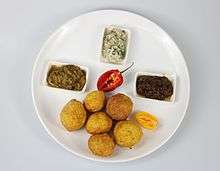Pholourie
 Pholourie with mango, coconut and tamarind chutneys | |
| Alternative names | Phulourie, phoulourie |
|---|---|
| Type | snack |
| Place of origin | Trinidad and Tobago |
| Associated national cuisine | Trinidad and Tobago cuisine |
| Serving temperature | warm |
| Main ingredients | split pea flour |
Pholourie (![]()
Overview
The dough is made up of flour, ground chickpeas, water and spices. Depending on the recipe, garlic, chili, turmeric, saffron, onions and/or cumin are used. Then dough balls the size of golf balls are formed and fried afterwards. The fried balls are usually served with a chutney to dip them in, usually tamarind or mango. Alternatively, yogurt can be used as a dip.
Pholourie is a popular street food in Guyana and Trinidad and Tobago and widely available from food carts and takeaways. It is famous in Debe. The dish was brought to Guyana and Trinidad Trinidad by migrants of Indian origin.[1][2] These Indians were recruited as indentured laborers after slavery had been abolished in the 19th century, and they brought their local recipes with them which they altered according to ingredients available in their new home. Over the decades, local taste slowly altered, leading to the Indian-based part of the Guyanese|Trinidadian cuisine known today.[3] Pholourie is widely connected to the Holi festival celebrated by Hindu Guyanese and Trinidadians.[4] The name "pholourie" probably originates from "fuluri", a dish from Bengali cuisine which bears some resemblance to the Indian pakoras dish.
In popular culture
One of Sundar Popo's most famous songs is called Pholourie Bina Chutney Kaise Bani.
References
- ↑ Phulourie receipe
- ↑ Indian Arrival Day
- ↑ Historic retrospect on Fiery-Foods.com
- ↑ Nelson, Cynthia (2011). Tastes Like Home. Kingston/Miami: Ian Randle Books. p. 258. ISBN 978-976-637-519-5.